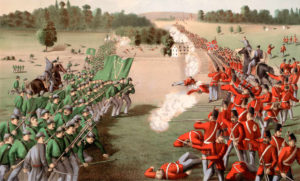The Battle of Ridgeway
A little more than 24 hours after leading an invasion of Canada with an Irish-American army, John O’Neill could see the enemy approaching. From his perch atop a limestone ridge outside the village of Ridgeway, Ontario, O’Neill could see an army three times the size of his marching in their direction. Although outnumbered, O’Neill’s Fenian army had the advantage of experience because many of them had fought in the Civil War.

As the Battle of Ridgeway began on the morning of June 2, 1866, the Canadian defense forces steadily pressed the Irish invaders back. The Fenians saw the familiar, hated red coats on the backs of the Thirteenth Infantry, but the green uniforms worn by the Queen’s Own Rifles presented a jarring target for the Irishmen. As they progressed through the fields toward the Fenian lines, the Canadians had to climb over or through a new fence every fifteen or twenty yards. With loaded rifles and bayonets at their sides, this took considerable effort and left them exposed.
The Canadians, however, maintained a steady advance to dislodge the Fenians from the thick timber that protected the center of their line. O’Neill feared that the enemy flanks had become so prolonged that his men could be enveloped. Knowing that he was outmanned, the Fenian colonel decided to undertake a risky maneuver, one that could only be tried with experienced troops.
O’Neill ordered his men to slowly fall back a few hundred yards to coax the Canadian center and form a new line. They acted, and believing the Irish in retreat due to the relatively small size of their force, the Canadians became bold with their attack. They charged ahead until they found themselves practically in a valley at the base of Limestone Ridge.
With their center uncovered, O’Neill waited until the Canadians were within one hundred yards. “Charge!” he suddenly shouted. The Fenians took the Canadians by surprise, unleashing a terrific volley. They sounded a chorus of wild Irish whoops as they advanced behind a green flag. On his horse, O’Neill appeared in the rear of the center of their line. The inexperienced Canadian commander panicked and ordered his militiamen to form a square, a textbook defensive position against a cavalry attack. Against the infantry attack, however, which was actually occurring, the defense forces were sitting ducks and soon ran for their lives from the battlefield.
For the first time since the 1745 Battle of Fontenoy, an Irish army had emerged victorious against forces of the British Empire. News of the Battle of Ridgeway consumed citizens on both sides of the international border. Toronto newspapers issued extra editions hourly, while The Boston Herald sold more copies of its edition covering the Fenian raid than it had after Lee’s surrender at Appomattox.
O’Neill’s victory incited joy among the Irish diaspora and in Ireland itself. The Nation in Dublin exulted in the news that “the red flag of England has gone down before the Irish green” and reported that the news “fills our people with tumultuous emotions impossible to describe, impossible to conceal.” The Detroit Free Press shook its head. “It is difficult to believe that any body of men who are not insane, have from this country invaded and committed acts of depredation or war against a nation with which we are at peace.”
The news stirred Irishmen across the United States, who now saw the Fenian Brotherhood was more than just bluster. From Louisiana to Maine, hundreds grabbed their rifles and boarded trains to Buffalo to join in the fight. Momentum was finally on their side.
To read what happened next in the incredible true story of the Civil War veterans who fought for Ireland’s freedom, order WHEN THE IRISH INVADED CANADA from your local bookstore (https://bit.ly/30I90OI), Amazon (https://amzn.to/30FhhTS), or Barnes & Noble (https://bit.ly/2HxPjSc).